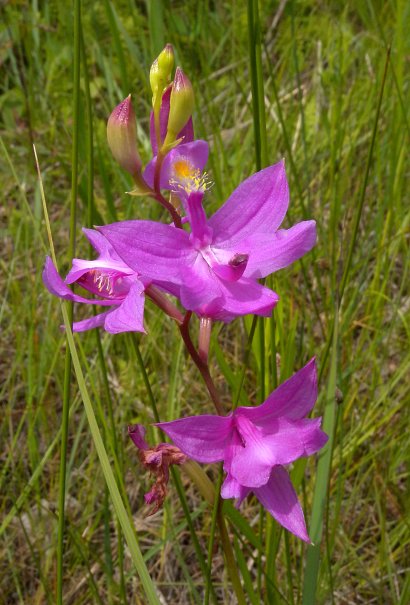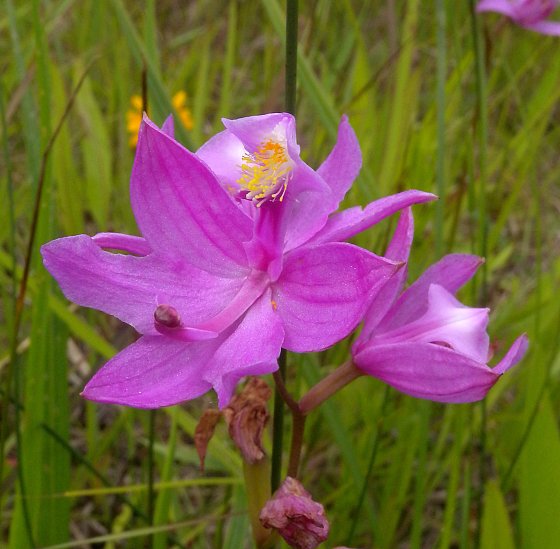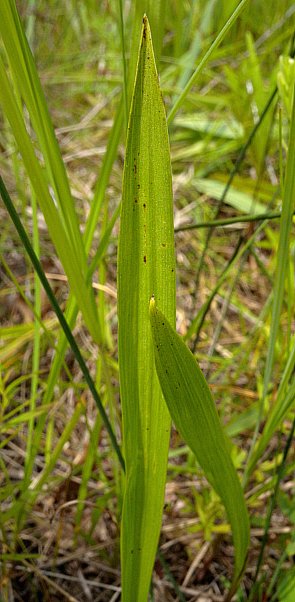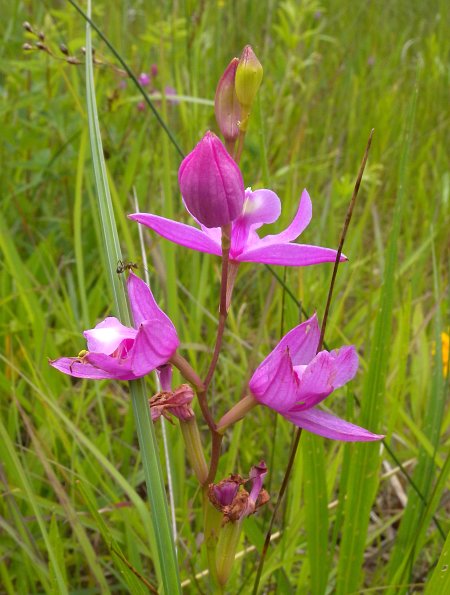
The central stem terminates in a spike of 2-15 flowers (rarely up to 20). The rachis of this floral spike is green to reddish purple, terete, and glabrous; it has a tendency to zig-zag between the flowers. Each flower is 1-2" across, consisting of 3 petaloid sepals, 3 petals, an exposed reproductive column, and an inferior ovary. Both the sepals and petals (excluding the petal that has been modified into a lip) are pink to deep rosy pink (rarely white); the sepals and petals may also have faint veins of dark rosy pink. The sepals are ovate or broadly oblong-ovate in shape, while the petals are broadly elliptic or elliptic-ovate in shape. Depending on the stage of development, both petals and sepals are spreading and more or less incurved from their tips; their upper surfaces are flat to somewhat concave. Both sepals and petals are nearly the same length (about ¾" long), although the sepals are a little wider. The third petal has been modified into an upper lip about ¾" long. This upper lip is linear in shape (grooved above and convex below), except toward its tip, where it has been widened by 2 lateral lobes; these lobes are half-orbicular to bluntly triangular in shape. At the center of this lobed tip, is a patch of white and a cluster of clubbed pseudo-stamens; these pseudo-stamens are hair-like in appearance and yellow to orange. Elsewhere, the lip is pink to rosy pink (rarely white) like the sepals and remaining petals. The lip is also hinged at its base.

The exposed reproductive column is mostly linear-flattened in shape, straight, and pink to rosy pink (rarely white). However, toward its tip, the reproductive column is upturned, terete along its center, and laterally lobed. The reproductive organs are located at the tip of the column, which is dark rosy pink. The reproductive column lies opposite from the upper lip of the flower; it is about ¾" long. The ascending inferior ovary, at the time of bloom, is light green to pale greenish pink, cylindrical-ribbed in shape, and glabrous. The blooming period usually occurs from early to late summer, lasting about 3-4 weeks. The flowers bloom sequentially from the bottom to the top of the floral spike. There can be either a mild floral fragrance or none. Afterwards, fertile flowers are replaced by seed capsules that are about ¾" long and ellipsoid-ovoid in shape; they eventually break open to release numerous tiny seeds, which are distributed by the wind. The root system consists of a globoid to ovoid corm with fibrous roots below.

Cultivation: The preference is full or partial sun, wet to moist conditions, and soil containing some sand and/or peat. Sometimes, this orchid is available from specialist orchid nurseries and it can be cultivated in gardens if its requirements are met. Wild plants, however, should never be collected.
Range & Habitat: The native Grass Pink Orchid has been found primarily in the northern half of Illinois and a few scattered counties elsewhere (see Distribution Map). This orchid is now rare and it is state-listed as 'endangered.' At one time, the Grass Pink Orchid was more abundant in Illinois, but its populations have declined because of habitat destruction and unscrupulous collecting. Habitats where this orchid can be found include wet to moist sand prairies, wet to moist sandy meadows, shallow sandy swales, openings in sandy swamps, fens, and bogs. This orchid is found in high quality natural areas.

Faunal Associations: Bumblebees and other large long-tongued bees are the primary pollinators of the flowers. Halictid bees, flies, butterflies, skippers, and beetles also visit the flowers occasionally, but they are unlikely to be effective at cross-pollination. See Cole (1988), Luer (1975), Small (1976), and Thien & Marcks (1972) for more information. Neither nectar nor accessible pollen are available to such flower-visiting insects. Instead, they are lured by deception to land on the showy flowers. In particular, they are often attracted to the colorful pseudo-stamens on the lip of the flower. If the visiting insect has sufficient weight, the hinged lip of the flower collapses onto its exposed reproductive column, attaching pollinia to the back of the insect. When the same insect visits the next flower, the same process can deposit the pollinia onto the exposed stigma of the reproductive column, enabling cross-pollination to occur. Like other orchids, the foliage and flowers of the Grass Pink Orchid are probably vulnerable to browsing by White-tailed Deer and other mammalian herbivores. When such animals are too abundant, it may be necessary to protect colonies and solitary plants of this orchid with wire cages or fencing.
Photographic Location: A shallow sandy swale at a nature preserve in Lake County, Illinois.

Comments: The structure of the flower for this orchid is highly unusual because its lip is located at the top rather than the bottom, causing the flower to appear upside-down (even though it is actually rightside-up). The Grass Pink Orchid is the most common species of its genus within the state and it is widely distributed within the eastern United States and SE Canada. The only other species of this genus within the state, the Oklahoma Grass Pink Orchid (Calopogon oklahomensis), is even more rare and it is also state-listed as 'endangered.' This latter orchid can be distinguished from the former as follows: 1) the petals and sepals of its flower are usually a lighter shade of pink, and 2) the lip of its flower has a patch of short pink pseudo-stamens above its showier yellow pseudo-stamens. The more common Grass Pink orchid lacks short pink pseudo-stamens on the lip of its flower. The Oklahoma Grass Pink Orchid is also found in drier habitats, like mesic prairies. Other common names of Calopogon tuberosus are Tuberous Grass Pink and Grass Pink, even though it is neither a grass nor a member of the Pink family (Caryophyllaceae).